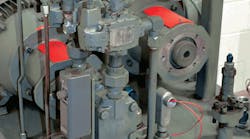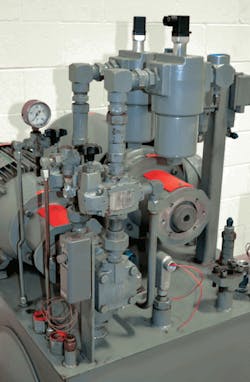The technician knew that all return lines should be below the oil level to prevent foaming. With this in mind, he drained the tank and inspected all the lines, making sure none were missing. After verifying that all were present, he checked to make sure all connections were tight.
After consulting with a hydraulic repair shop, he was told an air leak must be present in the intake, case drain, or shaft seal area. He recently had the pressure-compensated vane pump rebuilt by the same hydraulic repair shop. He figured it must be one of the lines leaking so he replumbed both the intake and case drain lines, but the problem still persisted. He inspected the shaft seal area, thinking it might be the cause, but it looked new and was dry on the outside.
Robert J. Sheaf Jr., is founder and president of CFC Industrial Training, a Div. of CFC Solar, which provides technical training, consulting, and field services to any industry using fluid-power technology. Visit www.cfc-solar.com for more information.
Any idea what's be causing the problem?
Solution to "root beer" foam problem:
We have found in the past that a cylinder with a run-away load and no flow controls or counterbalance valves could draw a vacuum at the rod seal when the piston rod retracts faster than the pump flow could keep up with, drawing air into the rod end of the cylinder. We weren’t quite sure this fit the symptoms but stranger things have reared their heads before.
After convincing ourselves that the cylinder wasn’t the cause, we shifted our focus to the pump area. We checked the re-plumbing of the inlet and case drain lines and applied a heavy coating of #2 grease to each joint — one joint at a time — but could not find an air leak.
Thinking that something did not look right, we then inspected the shaft seal area. Having run a repair shop for 10 years, we had rebuilt many of these types of pumps. We soon realized the pump was either missing the normal outer shaft seal, or it had been installed backwards.
Unlike piston pumps, pressure compensated vane pumps are not built with tight tolerances. When they decompensate, vane pumps actually draw oil out of the intake line and the pump case housing. These pumps require a standard shaft seal with the lip facing toward the oil to prevent external leaking. But they also need a second shaft seal installed with the lip facing outward. That’s because pressure-compensated vane pumps tend to draw a vacuum in the case when they decompensate to full volume. Without the second seal, air is drawn past the oil seal in to the case and then into the system. Because the oil seal is designed to prevent flow in only one direction, two seals should be installed back-to-back. In this case, only a single seal had been installed.


